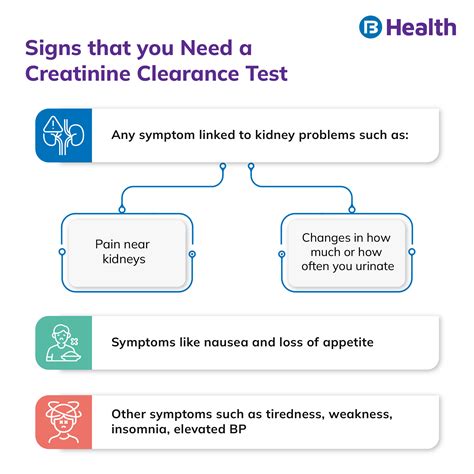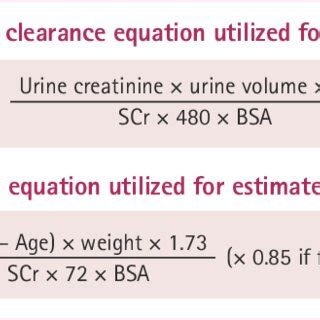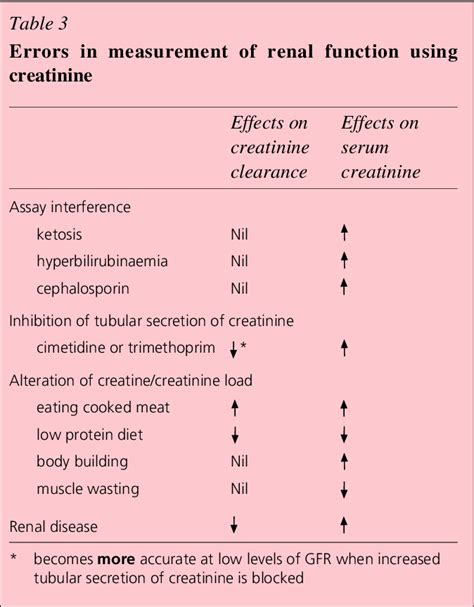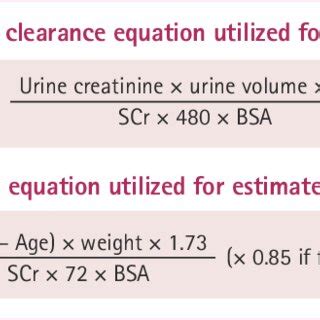Intro
The importance of understanding creatinine clearance range cannot be overstated, as it plays a crucial role in assessing kidney function and overall health. Creatinine is a waste product that is produced by the body's metabolic processes and is filtered out by the kidneys. By measuring the amount of creatinine in the blood and urine, healthcare professionals can estimate the glomerular filtration rate (GFR), which is a key indicator of kidney function. In this article, we will delve into the world of creatinine clearance range, exploring its significance, calculation methods, and implications for health and disease.
The kidneys are vital organs that perform a range of essential functions, including filtering waste and excess fluids from the blood, regulating electrolyte levels, and producing hormones that help control blood pressure and support bone health. When kidney function is impaired, waste products such as creatinine can build up in the blood, leading to a range of complications. By monitoring creatinine clearance range, healthcare professionals can identify potential kidney problems early on, allowing for prompt intervention and treatment. This can help prevent or slow the progression of kidney disease, reducing the risk of serious complications and improving overall health outcomes.
As we explore the concept of creatinine clearance range, it is essential to understand the various factors that can influence kidney function and creatinine levels. These include age, sex, body size, and underlying medical conditions, such as diabetes, hypertension, and kidney disease. Additionally, certain medications and substances, such as non-steroidal anti-inflammatory drugs (NSAIDs) and contrast agents, can affect kidney function and creatinine levels. By taking these factors into account, healthcare professionals can interpret creatinine clearance range results more accurately, making informed decisions about diagnosis, treatment, and management.
Creatinine Clearance Calculation

Calculating creatinine clearance range involves measuring the amount of creatinine in the blood and urine over a 24-hour period. The resulting value is then compared to a standard reference range to determine whether kidney function is normal or impaired. There are several methods for calculating creatinine clearance range, including the Cockcroft-Gault equation, the MDRD (Modification of Diet in Renal Disease) study equation, and the CKD-EPI (Chronic Kidney Disease Epidemiology Collaboration) equation. Each method has its strengths and limitations, and the choice of calculation method depends on individual patient characteristics and clinical context.
Factors Affecting Creatinine Clearance
The accuracy of creatinine clearance range results can be influenced by various factors, including: * Age: Creatinine clearance decreases with age, due to natural decline in kidney function. * Sex: Females tend to have lower creatinine clearance than males, due to differences in muscle mass and body size. * Body size: Creatinine clearance is higher in individuals with larger body size, due to increased muscle mass. * Underlying medical conditions: Kidney disease, diabetes, and hypertension can all affect creatinine clearance range. * Medications and substances: Certain medications and substances, such as NSAIDs and contrast agents, can affect kidney function and creatinine levels.Creatinine Clearance Range Interpretation

Interpreting creatinine clearance range results requires careful consideration of individual patient characteristics and clinical context. A creatinine clearance range of 90-120 mL/min/1.73m² is generally considered normal, indicating adequate kidney function. However, values below this range may indicate impaired kidney function, while values above this range may suggest hyperfiltration or other kidney problems. The following are some general guidelines for interpreting creatinine clearance range results:
- Normal: 90-120 mL/min/1.73m²
- Mild impairment: 60-89 mL/min/1.73m²
- Moderate impairment: 30-59 mL/min/1.73m²
- Severe impairment: 15-29 mL/min/1.73m²
- End-stage renal disease: <15 mL/min/1.73m²
Clinical Applications of Creatinine Clearance Range
Creatinine clearance range has a range of clinical applications, including: * Diagnosing and monitoring kidney disease * Assessing kidney function in patients with underlying medical conditions * Evaluating the effectiveness of treatments for kidney disease * Identifying potential kidney problems in patients with risk factors, such as diabetes and hypertension * Guiding medication dosing and management in patients with impaired kidney functionImplications of Abnormal Creatinine Clearance Range

Abnormal creatinine clearance range results can have significant implications for patient health and management. Impaired kidney function can increase the risk of complications, such as cardiovascular disease, anemia, and bone disease. Additionally, abnormal creatinine clearance range results may require adjustments to medication dosing and management, as well as lifestyle modifications to support kidney health. The following are some potential implications of abnormal creatinine clearance range results:
- Increased risk of cardiovascular disease
- Anemia and other blood disorders
- Bone disease and osteoporosis
- Neurological problems, such as cognitive impairment and peripheral neuropathy
- Fluid and electrolyte imbalances
Strategies for Maintaining Healthy Kidney Function
Maintaining healthy kidney function requires a range of strategies, including: * Controlling underlying medical conditions, such as diabetes and hypertension * Avoiding medications and substances that can harm the kidneys * Staying hydrated and managing fluid balance * Eating a healthy, balanced diet that is low in salt and protein * Exercising regularly and maintaining a healthy weight * Getting enough sleep and managing stressFuture Directions in Creatinine Clearance Range Research

Research into creatinine clearance range is ongoing, with a focus on developing new and more accurate methods for calculating and interpreting creatinine clearance range results. Additionally, studies are exploring the relationship between creatinine clearance range and various clinical outcomes, such as cardiovascular disease and mortality. The following are some potential areas of future research:
- Developing more accurate and reliable methods for calculating creatinine clearance range
- Exploring the relationship between creatinine clearance range and clinical outcomes
- Investigating the role of creatinine clearance range in diagnosing and monitoring kidney disease
- Evaluating the effectiveness of interventions aimed at improving kidney function and reducing the risk of complications
Conclusion and Recommendations
In conclusion, creatinine clearance range is a valuable tool for assessing kidney function and overall health. By understanding the factors that influence creatinine clearance range and interpreting results accurately, healthcare professionals can identify potential kidney problems early on, allowing for prompt intervention and treatment. To maintain healthy kidney function, individuals should focus on controlling underlying medical conditions, avoiding medications and substances that can harm the kidneys, and adopting healthy lifestyle habits, such as a balanced diet and regular exercise. Further research is needed to develop new and more accurate methods for calculating and interpreting creatinine clearance range results, as well as to explore the relationship between creatinine clearance range and clinical outcomes.What is creatinine clearance range, and why is it important?
+Creatinine clearance range is a measure of kidney function, calculated by measuring the amount of creatinine in the blood and urine over a 24-hour period. It is essential for assessing kidney health and identifying potential problems early on.
How is creatinine clearance range calculated, and what are the different methods?
+Creatinine clearance range is calculated using various methods, including the Cockcroft-Gault equation, the MDRD study equation, and the CKD-EPI equation. Each method has its strengths and limitations, and the choice of calculation method depends on individual patient characteristics and clinical context.
What are the implications of abnormal creatinine clearance range results, and how can they be managed?
+Abnormal creatinine clearance range results can increase the risk of complications, such as cardiovascular disease and anemia. Management strategies include controlling underlying medical conditions, avoiding medications and substances that can harm the kidneys, and adopting healthy lifestyle habits, such as a balanced diet and regular exercise.
We hope this article has provided valuable insights into the world of creatinine clearance range. If you have any questions or comments, please do not hesitate to share them with us. We encourage you to share this article with others who may benefit from this information, and we look forward to hearing your thoughts and feedback.
